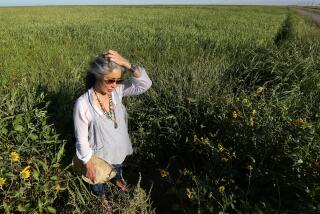We Built This City: Soil Survivors
- Share via
This isn’t going to be one of those romantic stories about how Tapia Brothers is one of the last holdouts of the old-time produce stands (even though it is), a dusty place in Encino with a wooden counter and bins of fresh veggies and fruits, roosters crowing from a coop and a red tractor. It’s just the kind of roadside stand that used to be a fixture in the San Fernando Valley when it was more American Gothic than suburb boom.
“Good,” says Tom Tapia, “because that story’s been done so much already.”
Right. So this story is more about how you go by a place for years and maybe stop in to buy some peaches or sweet corn, because you happen to be on the Ventura Freeway, and it’s right there off the Hayvenhurst exit, which leads straight into the Sepulveda Basin Recreation Area, a good place to walk a dog or play a game of catch with your nephew. Only thing is, you always end up making an illegal U-turn at Hayvenhurst and Burbank, because the stand is on the other side of the off-ramp, and you’re sure some motorcycle cop is going to ticket you one of these days.
Anyway, for years you’ve seen the faded green-and-yellow sign with its cursive letters proclaiming Tapia Bros. now, and then one day, you ask: What’s the deal with this place? Who are these people? And are those sunflowers in that Champion Seed bucket on sale?
“Good, much better,” says Tom. “I like that idea. What do you want to know?”
It turns out the place was formerly the family-owned Maria’s Corn Stand. Primo Tapia, Tom’s grandfather, had sold produce in Valencia—where the family farmed other property—since the early 1930s. Then development sprang up faster than ragweed. “Because of all the houses they were building, we got the boot. Just about then, the people at Maria’s wanted to quit the business, so they offered the stand to us.”
So, in an ironic twist, suburban development pushed them into the San Fernando Valley. The year was 1984. Primo eventually turned the business over to sons Felix and Charles, while other Tapias came in and out—nieces running cash registers, brothers farming corn. “When we were little, we spent our summers in the fields or the packing sheds, getting the produce ready to ship. As we got older...I don’t know, we just grew into it.” Tom’s kids started working the stand as soon as they could see over the counter.
Today, Tom and his brother Felix Jr. “kinda run the place,” but their dad and uncle still work. And there’s no shortage of work, what with 100 acres scattered across the San Fernando and Antelope valleys. Just when you’ve tilled and fertilized one section, it’s time to do another. Then there’s planting and pruning and spraying and harvesting. Then packing. Then shipping. “We used to have more siblings helping, but it’s hard work. The farm gets smaller and smaller; we grow less and less.”
Tom actively encouraged his kids to do something else—one is now a graduate of CSUN and teaches kindergarten, the other goes to college in South Carolina but helps out when he’s home. “It’s really expensive to farm now, and not very profitable for the small guy,” says Tom. No wonder the off season—January through April—is his favorite.
Yet it’s hard not to recall how in summer, the sugary starch of corn perfumes the air. How in October, the vivid orange of the pumpkin patch makes Halloween more festive. And how in December, the scent of pine and spruce wafts as families search for their Christmas tree.
“Yeah,” Tom admits, “it’s nice.”
He also gets a kick out of how the roosters’ crowing always startles first-timers. “They look around and go, ‘What the heck was that?’ ”
Still, urban produce stands are not exactly the next economic zeitgeist. Something will come along that’ll make the stand just an L.A. memory—maybe another flood in the basin, maybe the lease will not be renewed, maybe they’ll even widen the freeway. “They might add an off-ramp—who knows?” Tom says with a Zen-like shrug.
But until the Tapia Brothers have to pack it in, making that illegal U-turn will be worth it.
More to Read
Sign up for The Wild
We’ll help you find the best places to hike, bike and run, as well as the perfect silent spots for meditation and yoga.
You may occasionally receive promotional content from the Los Angeles Times.










